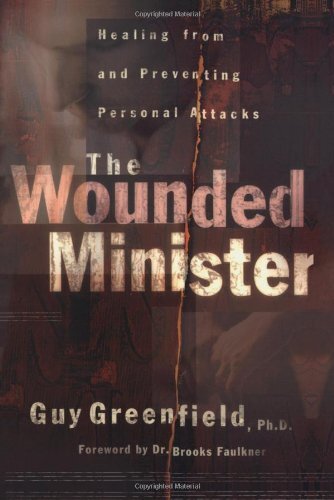Guy Greenfield, The Wounded Minister: Healing from and Preventing Personal Attacks. Baker Books, 2001.
Referenced in: Church Conflict – Criticism, Difficult People, Difficult Conversations
LifeandLeadership.com Summary
This is an insightful resource for ministers who have been deeply hurt by their experience in ministry, not only by personal attacks but also abusive churches. It seems to avoid the danger of encouraging ministers to externalize blame onto the offending institutions or persons, but neither does it absolve the unhealthy from the harm they do to ministers. I often say that ministers will probably encounter only two or three antagonists in their entire ministry, but the devastating impact of these relationships will be especially formative. When reading a book like this, one needs to be sure that the offender is indeed an antagonist. Nevertheless, these people certainly exist in congregations, and ministers need to be equipped to deal with them.
One of the main differences with this volume is that Greenfield writes with a sensitivity forged out of his own experience, which he recounts in the first chapter. He makes an interesting case that similar materials by Wayne Oates and Arthur Paul Boers that label mean-spirited people who target ministers as merely “troublesome” or “difficult” are too mild. He makes very respectful use of these authors as well as others such as Scott Peck and Lewis Smedes. However, without demonizing normal opposition in the church, he brings out a stark fact of life in ministry: In some churches there is evil, and ministers tend to be the primary victims of it. (17) The Apostle Paul dealt with this people in his ministry (2 Corinthians 11:5, 13, 15), as did Peter (2 Peter 2:1), and John (3 John 9-11). Many ministers experience the same today.
Greenfield spends the first section of the book explaining the factors that lead to clergy abuse. These include passive lay leaders who cower down and let it happen and hyper-autonomous church governance which enables pathological personalities to have their way. He next discusses the harmful effects these experiences have on a minister’s life, welfare, career, marriage, children, health, peace of mind, faith, retirement, etc. In section three, he lays out concrete suggestions for correction, especially how to get rid of clergy killers, pathological antagonists, and well-intentioned dragons. He also covers specific steps toward the healing of abused clergy with the intent to salvage, heal, and preserve. Another chapter looks at what the wounded minister can do for himself to recover shattered dreams and listen again to his call to ministry. This includes eventually getting to the point of being wounded healers for other ministers in pain. The author balances these chapters with one that addresses the other side of the problem, ministers who invite criticism and attack because they are mentally or emotionally disturbed. A part of this is ministering to church staff associates who are abused by these pathological pastors. The book ends with a program of growth for wounded ministers aimed at their recovery and restoration.
This is an excellent book. It is probably the best on the subject, though given the complexity of the issues, it should be supplemented with others.
From the Publisher
Are you a hurting pastor seeking healing? Are you a lay leader wanting to protect your pastor? Here is a compassionate, proactive look at pastoral abuse, a tragic reality that you can do something about. Every church deals with personality conflicts and intermittent discord. But in some congregations, there are people who intentionally attack leaders and initiate a devastating form of abuse-pastoral abuse. A growing phenomenon that cuts across denominational lines and impacts every level of ministry, pastoral abuse leaves in its wake wounded people with ruined ministries, broken relationships, damaged health, even shattered faith.
The Wounded Minister examines the reality of evil in churches and the ways in which “clergy killers” or “pathological antagonists” emotionally and spiritually batter pastors. A deft mix of personal experience and in-depth research, this resource will help wounded people of all ministerial positions learn how to recover their broken hearts while rebuilding their lives. As preventive medicine, it also provides guidelines on how sensitive Christians can develop a church structure that protects their pastors from this tragedy. Guy Greenfield is a former pastor and seminary professor who was wounded in ministry. He now offers and directs counseling services through Panhandle Pastoral Counseling Ministry in Amarillo, Texas. He is a member of the American Association of Pastoral Counselors and the American Association of Christian Counselors. Greenfield is also the author of several books, including The Wounded Parent.
About the Author
Guy Greenfield is a former pastor and seminary professor who now performs counseling services through Panhandle Pastoral Counseling Ministry, which he founded. He is the author of several books, including The Wounded Parent and Reigniting Love and Passion. He lives in Amarillo, Texas.
***For additional information on this resource, including reviews, click the bookstore links. Check the reference at page top or the links below for resource guides on related topics.***
Related Areas
See Other Resources on Church Conflict:
See Resources on Over 100 Areas of Ministry Leadership:


